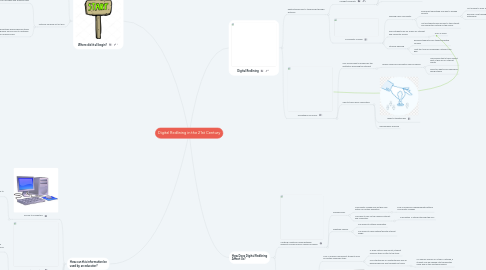
1. Where did it all begin?
1.1. Detroit, 1934
1.2. National Housing Act of 1934
1.2.1. Only specific areas of a city would be approved for mortages and financial loans
1.2.1.1. Cities divided into zones of approval
1.2.1.2. Those in the red zones would not be approved
1.2.2. Effectively barred specific ethnic groups from access to mortages or financial loans
1.2.2.1. Birwood Wall
1.2.2.1.1. 6 foot wall
1.2.2.1.2. Separates black and white neighbourhoods
1.2.2.2. Detroit became a prime example
2. How can this information be used by an educator?
2.1. Access to computers
2.1.1. Make sure all students have access to computers if needed
2.1.1.1. School computer access
2.1.1.2. Before/After school
2.1.1.3. During Lunch
2.2. Access to information
2.2.1. When giving an assignment, make sure information is discoverable within schools AUP
2.2.1.1. If not, provide alternate resources
2.2.1.2. Provide printed copies of articles
2.2.1.3. Books
2.3. Critically analyze AUP used by school
2.3.1. See if students information is being used
2.3.2. Which sites are blocked
2.3.3. Using this information, decide how information can be delivered without relying on hidden information
2.3.4. Don't use technology for the sake of using technology
2.3.4.1. May be needlessly disadvantaging students who don't have ready access to unfiltered Internet
2.3.4.2. Make use of SAMR model to decide if technology is necessary for the component being taught
2.4. Provide an equitable classroom dynamic
2.4.1. Make sure all students have equal access to computers
2.4.2. Provide access to resources for students who don't have personal Internet usage
3. Digital Redlining
3.1. Restriciting access to technology through systemic
3.1.1. College/University
3.1.1.1. Policy leans towards information freedom
3.1.1.1.1. Internet is not restricted
3.1.1.1.2. Access to large banks of journals and academic articles
3.1.1.2. Students have regular access to Internet and computers outside of the school domain
3.1.1.3. Freedom to select courses that interest you
3.1.2. Community College
3.1.2.1. Working class community
3.1.2.1.1. Enrollment advertised as a way to escape poverty
3.1.2.1.2. Not all students have access to the Internet and computers outside of the school
3.1.2.2. many students rely on school for Internet and computer access
3.1.2.2.1. AUPs in Place
3.1.2.3. Intrusive advising
3.1.2.3.1. disuade studensts from taking unrelated courses
3.1.2.3.2. Limit the type of knowledge a student can gain
3.2. Acceptable Use Policy
3.2.1. only access what is allowed by the institution providing the Internet
3.2.1.1. Whole caches of information can be missed
3.2.1.1.1. May believe that a topic doesn't exist if their are no Internet results
3.2.1.1.2. Result of what you're searching being filtered
3.2.2. Able to track user's information
3.2.2.1. Leads to targeted ads
3.2.2.2. demographic profiling
4. Community Colleges are denied access to information and kept on a straight path predetermined by industry demands
5. How Does Digital Redlining Affect Us?
5.1. Creating a systemic divide between different socioeconomic classes of people
5.1.1. Working class
5.1.1.1. Community college may be their only option for further education
5.1.1.1.1. 50% of American undergraduates attend community colleges
5.1.1.2. May have to rely on the campus Internet and computers
5.1.1.2.1. Information is filtered through the AUP
5.1.2. Wealthier classes
5.1.2.1. Can afford to attend universities
5.1.2.2. Can afford to have laptops/private Internet usage
5.2. Limit knowledge and understanding of society for students
5.2.1. AUP in schools can prevent students from accurately learning a topic
5.2.1.1. A query returns few results, student assumes there is little to the topic
5.2.1.2. Can intentionally or unintentionally end up guiding opinions and thoughts on topics
5.2.1.2.1. If a specific opinion on a topic if filtered, a student may be swayed into thinking the same way as the unfiltered opinion
5.2.2. Can guide demographics of people into viewpoints
5.2.2.1. Targeted ads towards specific demographics

